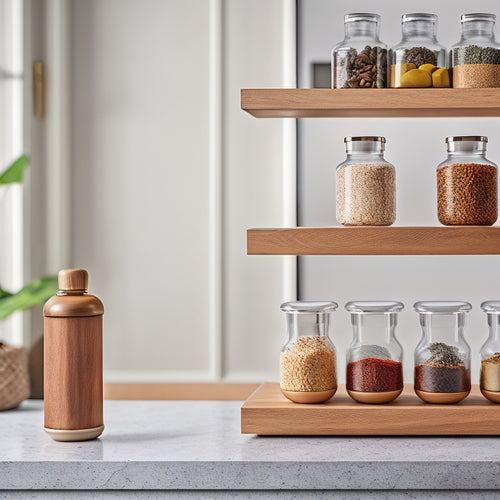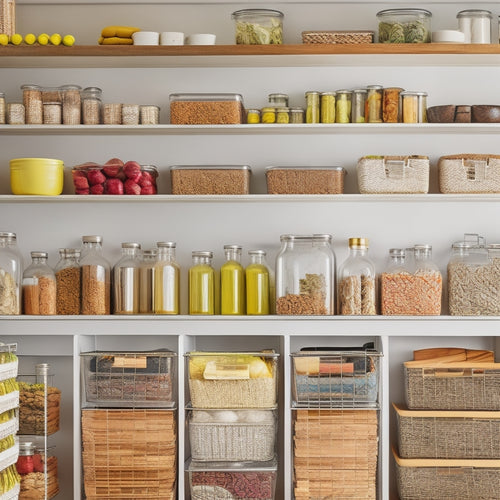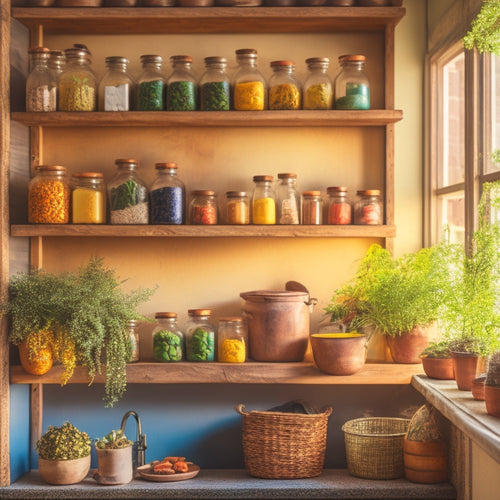
Why So Cluttered? 7 Small Kitchen Pantry Hacks
Share
You're tired of feeling overwhelmed every time you open your pantry door. The solution starts with a clean slate - clear out everything and sort items into keep, donate, and discard piles. Be ruthless about eliminating expired or unused items. Then, categorize and group similar items together, assigning a home for each one. Maximize your space by utilizing vertical storage and the back of the door for additional storage. Finally, incorporate baskets and containers to keep items organized and visually appealing. By following these steps, you'll be on your way to a clutter-free pantry that makes meal prep a breeze - and there's more to explore to make sure your pantry stays organized for good.
Key Takeaways
• Clear your pantry completely and sort items into keep, donate/sell, and discard piles to start with a clean slate.
• Categorize and group similar items together, labeling everything for easy access and rotating stock to reduce waste.
• Assign a home for each item, designating specific zones and labeling shelves, baskets, and containers for easy identification.
• Maximize vertical storage by installing shelves, hooks, or pegboards to free up floor and counter space for essential items.
• Utilize the back of the door and incorporate baskets and containers to organize pantry contents, labeling each for quick identification.
Start With a Clean Slate
Clear everything out of your pantry and sort items into three piles: keep, donate/sell, and discard, to give yourself a fresh start. This step is essential in organizing your pantry efficiently and decluttering effectively.
Be ruthless – if you haven't used it in the past year, it's probably safe to get rid of it. As you sort, consider the expiration dates of perishable items and the condition of non-perishable ones. If you're unsure about an item, ask yourself if it's worth the space it's taking up in your pantry.
Once you've sorted your items, take a closer look at what you're keeping. Are there any duplicates or expired items? Get rid of them.
Now, take a step back and assess your pantry's layout. Are there any areas that are hard to reach or prone to clutter? Think about how you can optimize the space to make it more functional.
Categorize and Group Similar Items
Categorizing your pantry items into groups like baking supplies, snacks, and dinner staples helps you visualize how you use your space and makes it simpler to find what you require when you need it. This simple step will save you time and frustration in the long term.
Once you've organized your items, take it a step further by grouping similar items together. For instance, store all your baking supplies, such as flour, sugar, and baking powder, in one area. This way, when you need to prepare a cake, you'll know precisely where to find everything.
To elevate your categorization to the next level, label everything. Use labels or stickers to identify what's inside containers or on shelves. This will aid you and others swiftly identify what's inside without having to dig through everything.
Another crucial tip is to rotate your stock. Make certain the oldest items are in front and the newest items are in back. This secures that you use the oldest items before they expire, reducing waste and saving you money.
Assign a Home for Each Item
Now that you've categorized, grouped, and labeled your pantry items, it's time to take the next step and assign a specific home for each item, ensuring everything has a designated place where it's easily accessible. This will help maintain the organization you've established and make it easier to find what you need when you need it.
Start by designating specific zones for different types of items, such as a baking zone or a snack zone. Within each zone, label everything, including shelves, baskets, and containers, so you can quickly identify where items are stored. This will also help you identify what's running low and what you need to restock.
Use Vertical Storage to Maximize Space
By installing shelves, hooks, or a pegboard, you can take advantage of your pantry's often-wasted vertical space and free up valuable floor and counter space for more essential items. This will give you more room to move around and make meal prep a breeze.
Consider adding wall shelves to store infrequently used items, like special occasion dishes or cookbooks. Hanging hooks can hold bags, aprons, or even utensils, keeping them organized and within reach. For a more customizable option, a pegboard allows you to add or remove hooks and bins as needed.
Don't forget to utilize the space above your pantry shelves by using stackable bins to store dry goods or snacks. Meanwhile, drawer organizers can help keep utensils and gadgets tidy.
Utilize the Back of the Door
You can squeeze even more storage out of your pantry by repurposing the back of the door into a valuable storage space. This often-wasted area can be transformed into a space-saving solution with the right tools.
By utilizing vertical space, you can hang shelves or install door-mounted organizers to hold items like spices, oils, or snacks.
Here are a few ideas to get you started:
-
Install a shoe organizer or a hanging pocket organizer to store small items like packets, spices, or coffee creamer.
-
Use adhesive hooks to hang baskets or bags filled with snacks, tea, or coffee.
-
Mount a narrow shelf or a magnetic board to store small appliances, cookbooks, or kitchen gadgets.
Incorporate Baskets and Containers
Organize your pantry's contents into categories and assign a designated basket or container to each group, keeping similar items together for easy access. This will help you find what you need quickly and prevent clutter from building up again. Label each basket or container so you can see what's inside without having to dig through everything. This label organization will save you time and frustration in the long run.
To take your organization system to the next level, try color coding your baskets. Assign a specific color to each category, such as baking supplies or snacks. This visual cue will help you quickly identify where items belong and make it easier to maintain your system. For example, you could use red baskets for baking supplies and green baskets for snacks.
With a little creativity, you can create a pantry system that's both functional and visually appealing. By incorporating baskets and containers into your pantry, you'll be able to keep your kitchen organized and make meal prep a breeze.
Implement the "First In, First Out" Rule
To secure that your newly organized pantry stays clutter-free, it's time to implement a system that promotes you to use the oldest items first. This is where the 'First In, First Out' rule comes in - a simple yet effective strategy for inventory management. By using this method, you'll make sure that older items are consumed before they expire, reducing food waste and saving you money.
Here are a few ways to put this rule into practice:
** Place new items behind existing ones on your shelves to encourage rotation.
** Label each item with its expiration date or the date you purchased it, so you can easily identify what needs to be used first.
** Group similar items together (like canned goods or baking supplies) and arrange them in order of expiration date, with the oldest items front and center.
Frequently Asked Questions
How Often Should I Clean and Organize My Kitchen Pantry?
Coincidentally, you're thinking about pantry maintenance just when clutter's starting to creep in! Clean and organize your kitchen pantry every 1-2 months, using effective methods like categorizing, labeling, and wiping down shelves to keep it spotless and functional.
Can I Use Makeshift Containers or Should I Buy Specific Ones?
You can definitely use upcycled containers, but consider buying specific ones for a more streamlined look. Either way, get creative with organization hacks, like labeling and categorizing, to maximize your pantry's potential.
What if I Have Items That Don't Fit Into Categories?
Did you know 80% of kitchen items are used less than 20% of the time? When facing items that don't fit into categories, you'll find miscellaneous storage solutions and creative shelving options help you cleverly stow away those oddball items.
How Do I Prevent Pests From Getting Into Stored Food?
To prevent pests from getting into stored food, you'll want to focus on proper food storage and organization tips. Use airtight containers, sealable bags, and store them in a cool, dry place, implementing effective pest control and prevention strategies.
Are There Any Pantry Organization Apps to Help Me Track Items?
'As you start on a quest for a clutter-free pantry, you'll find solace in pantry organization apps that help you track items and maintain a virtual inventory, making meal planning and grocery shopping a breeze.'
Related Posts
-

Modern Countertop Spice Organizer Designs
Modern countertop spice organizer designs enhance your kitchen's aesthetics while maximizing functionality. These spa...
-

Tiered Racks for Kitchen Pantry Organization
Tiered racks can enhance your kitchen pantry by maximizing vertical storage and increasing visibility. They help you ...
-

Wall Racks for Storing Kitchen Herbs and Spices
Wall racks for storing kitchen herbs and spices are a revolutionary advancement for maximizing your kitchen space. Th...


